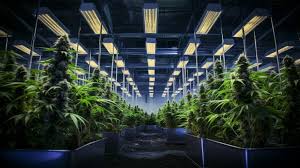Energy Efficiency Rebate & Incentive Programs offer indoor and greenhouse growers the opportunity to improve sustainability while reaping substantial financial benefits. In particular, cannabis cultivation facilities are among the most energy-intensive operations in agriculture, with lighting systems accounting for a significant portion of operational costs. By upgrading to energy-efficient LED lighting and leveraging rebate incentives, cultivators can dramatically reduce overhead expenses and improve long-term profitability. They are also offered for HVAC systems, dehumidifiers and more, yet LED lights offer the greatest financial incentives do to their high upfront costs and substantial energy savings by choosing these energy efficient lights.
Understanding LED Rebates and Incentives
Rebate & Incentive Programs for LED light are financial incentives provided by utility companies, state energy programs and regional sustainability initiatives. These programs aim to reduce energy consumption by encouraging the adoption of high-efficiency lighting systems like LEDs. For cultivators, these rebates can offset the initial cost of upgrading to LEDs while delivering lasting financial and operational advantages. They are often offered for new projects, the replacement of HPS lights and expansions.
The Financial Impact of LED Rebates on Cultivation
The Benefits of LED Lighting
- Energy Efficiency
LED grow lights consume approximately 40% less energy than traditional lighting systems such as high-pressure sodium (HPS) or metal halide lamps. This efficiency reduces electricity bills and helps growers align with sustainability goals. - Precision Lighting
LEDs offer customizable light spectrums tailored to specific growth stages, improving photosynthesis and plant health. With better control, growers achieve higher yields and superior product quality. - Reduced Heat Output
Unlike traditional lights, LEDs produce minimal heat, decreasing the need for cooling systems. This not only saves energy but also ensures a more stable growing environment for plants.
Long-Term Savings on Energy Costs
- Energy Efficiency: LED lights consume up to 50–70% less energy than traditional systems, translating to substantial savings on electricity bills.
- Heat Management: LEDs produce significantly less heat, reducing the need for energy-intensive HVAC systems to maintain optimal grow-room temperatures. This dual effect compounds energy savings.
For example, a 10,000-square-foot facility with traditional lighting may spend $250,000 annually on energy. By switching to LEDs, energy costs could drop by as much as $100,000 annually.
Return on Investment (ROI)
- Payback Period: With rebates and energy savings combined, most facilities recoup their investment in LED upgrades within 12–24 months. Beyond this period, the savings contribute directly to profitability.
- Increased Yield Efficiency: LEDs optimize light output and, if utilized properly, can boost crop quality and yield. Improved crop value enhances the ROI even further.
Compliance and Avoiding Penalties
- Meeting Energy Regulations: Many states impose energy efficiency requirements for cannabis cultivators, including wattage-per-square-foot caps. LED installations ensure compliance, avoiding potential fines or operational delays.
- Sustainability Credits: In regions with green energy mandates, LED adoption may qualify facilities for additional incentives or tax credits, further reducing financial burdens.
How to Qualify for LED Rebates
To take advantage of rebates, growers need to:
- Choose Certified Products: Many rebate programs require the use of DLC (DesignLights Consortium) certified LED fixtures.
- Meet Energy Goals: Programs often assess current energy use and savings projections.
- Submit Applications: Provide documentation such as utility bills, installation plans, and product details. This process can be tedious and many choose to hire a rebate expert to help them with the process.
By participating in rebate programs, cultivators can significantly reduce the initial costs of LED lighting installations, making the transition more accessible.
Why LED Rebates Are Essential for Horticulture
In a competitive industry, LED rebate programs enable both small-scale and commercial growers to modernize operations while staying profitable. Reduced energy costs, coupled with better plant performance, enhance the overall efficiency and sustainability of horticulture practices.
Conclusion
LED lighting combined with rebate incentives offers a clear path toward sustainable and cost-effective cultivation. By upgrading to energy-efficient technology, cannabis cultivators and horticulturists not only improve operational efficiency but also contribute to broader environmental goals. For growers ready to embrace the future of lighting, LED rebates provide the financial support needed to take the next step.
By leveraging these programs, cultivators can future-proof their operations for a more sustainable and profitable future. Would you like more guidance on applying for rebates or optimizing LED systems for your facility? Contact Us





